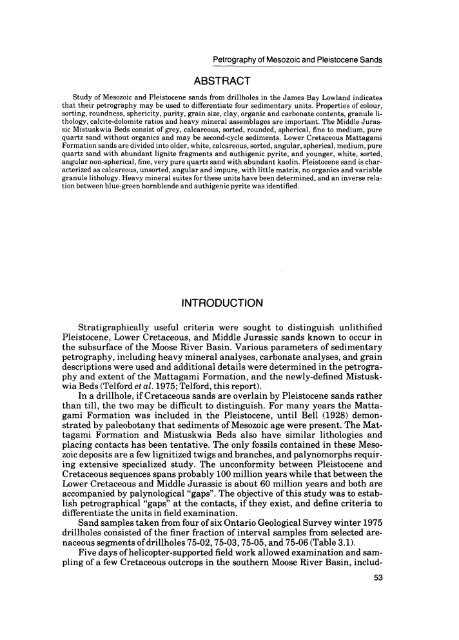Moose River Basin: geology and mineral potential - Geology Ontario
Moose River Basin: geology and mineral potential - Geology Ontario
Moose River Basin: geology and mineral potential - Geology Ontario
Create successful ePaper yourself
Turn your PDF publications into a flip-book with our unique Google optimized e-Paper software.
Petrography of Mesozoic <strong>and</strong> Pleistocene S<strong>and</strong>s<br />
ABSTRACT<br />
Study of Mesozoic <strong>and</strong> Pleistocene s<strong>and</strong>s from drillholes in the James Bay Lowl<strong>and</strong> indicates<br />
that their petrography may be used to differentiate four sedimentary units. Properties of colour,<br />
sorting, roundness, sphericity, purity, grain size, clay, organic <strong>and</strong> carbonate contents, granule li<br />
thology, calcite-dolomite ratios <strong>and</strong> heavy <strong>mineral</strong> assemblages are important. The Middle Juras<br />
sic Mistuskwia Beds consist of grey, calcareous, sorted, rounded, spherical, fine to medium, pure<br />
quartz s<strong>and</strong> without organics <strong>and</strong> may be second-cycle sediments. Lower Cretaceous Mattagami<br />
Formation s<strong>and</strong>s are divided into older, white, calcareous, sorted, angular, spherical, medium, pure<br />
quartz s<strong>and</strong> with abundant lignite fragments <strong>and</strong> authigenic pyrite, <strong>and</strong> younger, white, sorted,<br />
angular non-spherical, fine, very pure quartz s<strong>and</strong> with abundant kaolin. Pleistocene s<strong>and</strong> is char<br />
acterized as calcareous, unsorted, angular <strong>and</strong> impure, with little matrix, no organics <strong>and</strong> variable<br />
granule lithology. Heavy <strong>mineral</strong> suites for these units have been determined, <strong>and</strong> an inverse rela<br />
tion between blue-green hornblende <strong>and</strong> authigenic pyrite was identified.<br />
INTRODUCTION<br />
Stratigraphically useful criteria were sought to distinguish unlithified<br />
Pleistocene, Lower Cretaceous, <strong>and</strong> Middle Jurassic s<strong>and</strong>s known to occur in<br />
the subsurface of the <strong>Moose</strong> <strong>River</strong> <strong>Basin</strong>. Various parameters of sedimentary<br />
petrography, including heavy <strong>mineral</strong> analyses, carbonate analyses, <strong>and</strong> grain<br />
descriptions were used <strong>and</strong> additional details were determined in the petrogra<br />
phy <strong>and</strong> extent of the Mattagami Formation, <strong>and</strong> the newly-defined Mistusk<br />
wia Beds (Telford et al. 1975; Telford, this report).<br />
In a drillhole, if Cretaceous s<strong>and</strong>s are overlain by Pleistocene s<strong>and</strong>s rather<br />
than till, the two may be difficult to distinguish. For many years the Matta<br />
gami Formation was included in the Pleistocene, until Bell (1928) demon<br />
strated by paleobotany that sediments of Mesozoic age were present. The Mat<br />
tagami Formation <strong>and</strong> Mistuskwia Beds also have similar lithologies <strong>and</strong><br />
placing contacts has been tentative. The only fossils contained in these Meso<br />
zoic deposits are a few lignitized twigs <strong>and</strong> branches, <strong>and</strong> palynomorphs requir<br />
ing extensive specialized study. The unconformity between Pleistocene <strong>and</strong><br />
Cretaceous sequences spans probably 100 million years while that between the<br />
Lower Cretaceous <strong>and</strong> Middle Jurassic is about 60 million years <strong>and</strong> both are<br />
accompanied by palynological "gaps". The objective of this study was to estab<br />
lish petrographical "gaps" at the contacts, if they exist, <strong>and</strong> define criteria to<br />
differentiate the units in field examination.<br />
S<strong>and</strong> samples taken from four of six <strong>Ontario</strong> Geological Survey winter 1975<br />
drillholes consisted of the finer fraction of interval samples from selected are<br />
naceous segments of drillholes 75-02,75-03,75-05, <strong>and</strong> 75-06 (Table 3.1).<br />
Five days of helicopter-supported field work allowed examination <strong>and</strong> sam<br />
pling of a few Cretaceous outcrops in the southern <strong>Moose</strong> <strong>River</strong> <strong>Basin</strong>, includ-<br />
53

















